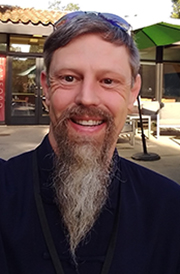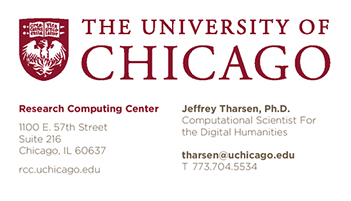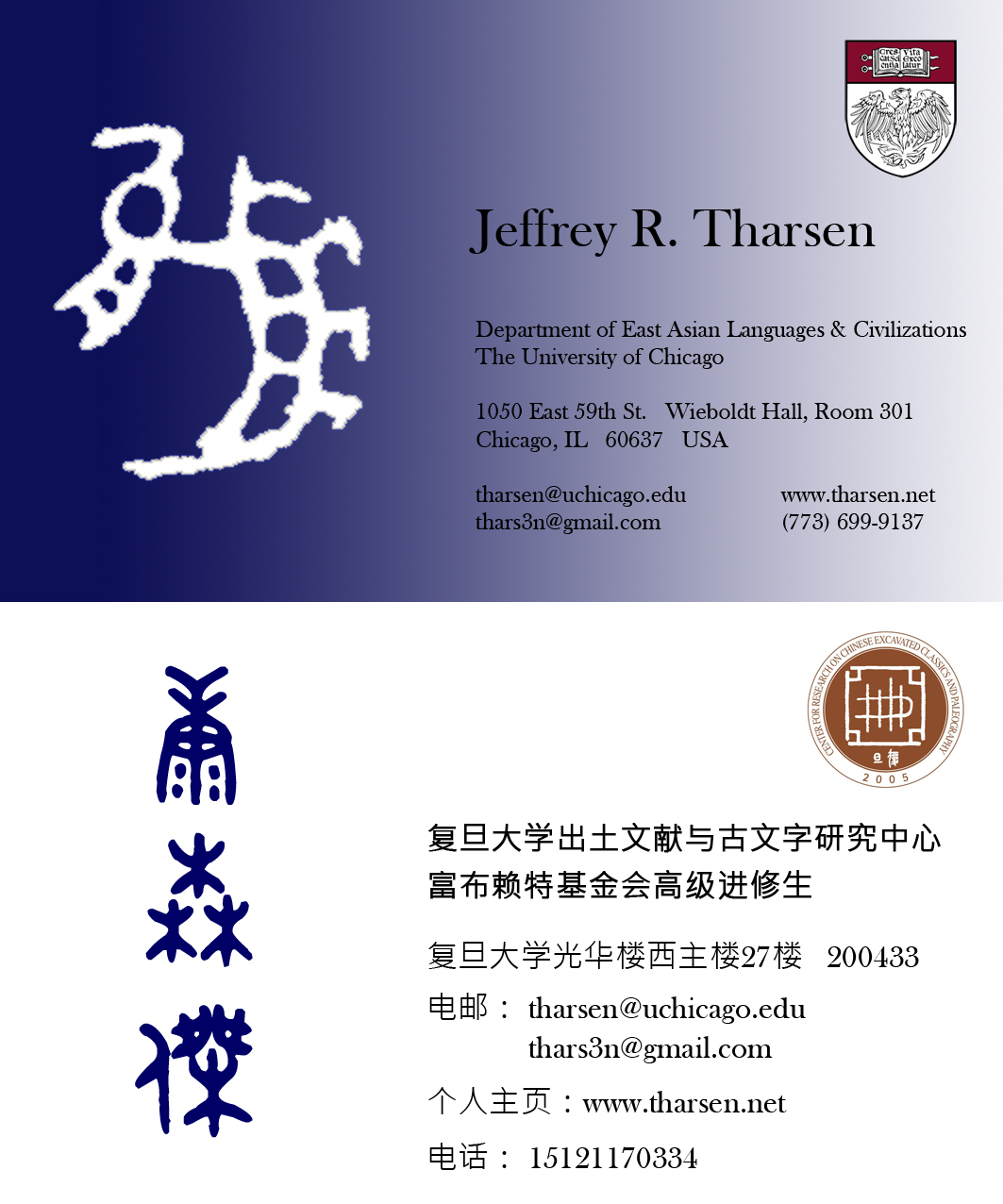![This is the famous opening line of the recently-discovered mid-4th-century BCE manuscript 'Confucius's Essay on the Poetry' 〈孔子詩論〉. It reads: 'Poetry is not sparing of will [=desire]; Music is not sparing of emotions; Literary eloquence is not sparing of [words/meaning].' 孔子曰:「詩亡吝志,樂亡吝情,文亡吝[言/意]。」](./academics/images/kongzishilun1g.jpg)

Jeffrey R. Tharsen 康森傑
Associate Director of Technology
Lecturer in the Humanities and in the College
M.A. Thesis Counselor
Digital Humanities Forum co-chair (2016-present)
Dept. of East Asian Languages & Civilizations (Ph.D. 2015)
Forum for Digital Culture, Division of the Humanities
The University of Chicago
Teaching and Research
My work is informed by a diverse variety of languages and literary traditions, ancient classics and cutting-edge technologies. Over the last 25 years I've been primarily engaged in the study of premodern literatures and linguistics, intertextuality and philology. Fascinated by the ways literary artistry in poetry and prose utilized various forms of phonological patterning, I've been working to develop new computational methodologies and digital systems to reveal the intricate ways acoustics, metrics and semantics are employed in concert in texts. It is my hope that these new approaches will help us better understand the classic works produced by some of our most ancient civilizations, how their contents and uses transformed over time, and how we can best employ new methods to bring the lessons from their words, their histories, and the cultures that produced them to modern audiences.
My research into the early development of Chinese literature and poetics utilizes a mix of modern linguistic and computational strategies and traditional methodologies, mainly centered on philology, historiography, intellectual history, paleography, epigraphy and literary studies. Over the past decade I've also been teaching and working in the nascent fields of digital humanities and artificial intelligence, focusing on computational approaches to intertextuality and philology, developing new types of systems for textual analytics, new data architectures and new methodologies and frameworks for linguistic and textual analysis in a wide variety of languages and traditions.
As the Humanities Division's Associate Director of Technology, I serve both as primary mentor to students interested in pairing humanities research methodologies with computational techniques and as director of teams of students, engineers and scholars working to bring individualized research projects with digital and/or computational components to fruition and provide new insights into established disciplines. In the Digital Studies program, I teach advanced computational methods and their applications in specific humanities disciplines, such as natural language processing and computational linguistics, A.I. and deep learning, large language model (LLM) architectures, network analysis, machine learning, text mining, segmentation, automated text parsing, and a variety of advanced data analysis and visualization strategies.
* * *
On Chinese Euphonics:
About two decades ago I was struck by the following question: How can we hear what Shakespeare’s plays sounded like in his time, or Sappho’s verses, or the songs of ancient Sumer? As they were written in phonetic scripts, modern historical linguists have largely been able to reconstruct the sounds of these works. Chinese has always utilized a logographic as opposed to a phonetic script, so dramatic shifts in pronunciation down through the millennia have largely obscured the original sounds of the language; much premodern Chinese rhyming poetry no longer rhymes and many of the intricate phonological patterns in classical prose have been completely lost. In an attempt to create a method via which scholars can approximate the original sounds of these works in their entirety, I developed a digital phonological toolkit and suites of computational tools that permit the efficient, broad comparative analysis of the complete sound patterns in any Chinese text, modern, premodern or ancient.
Initial results have provided new evidence for intricate phonological patterning in many of the great classics of the Chinese canon: the elegant euphony, prosody and literary artistry of ancient masterworks of poetry and prose.
This new method also allows for the efficient use and comparative evaluation of phonological systems and can be a useful tool for teachers, learners and scholars of modern and classical languages, phonology and poetics.
Thanks to modern database technologies and new types of digital texts and digital tools, we can now efficiently muster and deploy a wide variety of lexical and textual resources with just a few clicks of the mouse: The Digital Etymological Dictionary of Old Chinese (edoc.uchicago.edu) mentioned above is an online toolkit via which any user can instantly perform comparative phonological and phonorhetorical analyses of virtually every graph in any user-provided Chinese text.
For selected Conference Papers, Lectures and Workshops, see Curriculum Vitae
Selected Recent Publications: Books
Chinese Euphonics: Phonological Patterns, Phonorhetoric and Literary Artistry in Early Chinese Narrative Texts
Berlin: DeGruyter ©2024
ISBN: 978-3110663105 PDF
Digital Methods for Traditional Chinese Literary Studies.
Journal of Chinese Literature and Culture 5.2, Special Edition, Nov. 2018.
ISBN 978-1-4780-0496-7
Co-Editor, with Thomas J. Mazanec and Chen Jing
Selected Recent Publications: Articles, Translations, Book Chapters, Software
Dombroski, Quinn; Gniady, Tassie; Kloster, David; Meredith-Lobay, Megan; Tharsen, Jeffrey and Zickel, Lee. “Voices from the Server Room: Humanists in HPC.” In Computational Humanities, University of Minnesota Press, 2024. Series Editors: Jessica Marie Johnson, David Mimno, Lauren Tilton.
“Offering for Qu Yuan 祭屈原文.” In Eternal Nostalgia: An Anthology of Mourning Poems and Prose/Essays from
Imperial China, eds. Victor Mair and Zhenjun Zhang, Columbia University Press, 2024.
“From Form to Sound 自形至聲 : Visual and Aural Representations of Premodern Chinese Phonology and Phonorhetoric with Applications for Phonetic Scripts.” International Journal of Digital Humanities 4, 2023. doi.org/10.1007/s42803-022-00053-8 PDF
Tharsen, Jeffrey and Gladstone, Clovis. “TextPAIR Viewer (TPV) 1.0: An Interactive Visual Toolkit for Exploring Networks of Text Alignments and Text Reuse.” Shuzi renwen 數字人文 2, 2022. PDF
Tharsen, Jeffrey and Gladstone, Clovis. “Using Philologic For Digital Textual and Intertextual Analyses of the Twenty-Four Chinese Histories 二十四史.” Journal of Chinese History 4.2, 2020: 558–63. doi.org/10.1017/jch.2020.27 PDF
“Comparative Phonorhetorical Analyses of Speeches in the Zuo Commentary and the Discourses of the States”, In Journal of Chinese Literature and Culture 6.2, Autumn 2019. Journal Editor: Cai Zong-qi 蔡宗齊. www.chinesepoetryforum.org/?page_id=858#6.2 PDF
“早期中国散文中作为文本构建工具的音韵修辞和音韵模式” [“Phonorhetoric and Phonological Patterns as Text-Structuring Devices in Early Chinese Prose”], In Studies in Prosodic Grammar《韻律語法研究》 2019 (2), Autumn 2019. Journal Editor: Feng Shengli 馮勝利. ISBN 978-7-5619-4894-1 PDF
The Digital Etymological Dictionary of Old Chinese 《古漢語詞源字典》 1.0, digital metadictionary and suite of computational tools designed to assist with the analysis of phonological and phonorhetorical structures in Chinese texts, 2010-present. Accessible online at edoc.uchicago.edu
chapakhana 1.0, website featuring series of interactive maps in CartoDB allowing users to explore the history of printing in South Asia, including a gallery of images taken from the printing houses and their publications, 2017-19 (PI: U.Stark, website designer: S.Elahi). Accessible online at chapakhana.rcc.uchicago.edu
The Sign And Gesture Archive (SAGA), large-scale digital archive of videos of signers/homesigners, gesturers and speakers plus associated metadata and annotation/coding files, including basic and advanced search and view modules with full security apparatus for IRB privacy controls, 2015-present. Currently in development; accessible online at saga.rcc.uchicago.edu
“Review: Reading Philosophy, Writing Poetry by Wendy Swartz”, In CLEAR (Chinese Literature: Essays, Articles, Reviews) 40 (2018). Editor: William H. Nienhauser, Jr. ISSN 0161-9705
Tharsen, Jeffrey R., Mazanec, Thomas J. and Chen Jing. “Introduction” In Digital Methods for Traditional Chinese Literary Studies, Journal of Chinese Literature and Culture 5.2, Special Edition, November 2018. doi.org/10.1215/23290048-7256950 PDF
Liu Chao-Lin 劉昭麟, Mazanec, Thomas J. and Tharsen, Jeffrey R. “Exploring Chinese Poetry with Digital Assistance: Examples from Linguistic, Literary, and Historical Viewpoints,” In Digital Methods for Traditional Chinese Literary Studies, Journal of Chinese Literature and Culture 5.2, Special Edition, November 2018. doi.org/10.1215/23290048-7257002 PDF
The Visual Text Explorer (VTE) 1.0, user-customizable interactive digital visual interface designed for analytics of words and phrases in user-provided sources, allowing for simultaneous close and distant reading and multidimensional data analytics, 2016-2018. Accessible online at edoc.uchicago.edu/vte
Chinese Euphonics: Phonetic Patterns, Phonorhetoric and Literary Artistry in Early Chinese Narrative Texts, Ph.D. dissertation, University of Chicago, 2015 (Chinese Euphonics manuscript under contract and accepted for publication, DeGruyter “Worlds of East Asia” series, publication 2024.) doi.org/10.6082/M1XS5S9K
Intertext 0.9, customizable digital toolkit designed to assist with the identification and philological analysis of words and phrases in series of files, 2014-16 [Currently in beta at edoc.uchicago.edu/textccr.]
“Talking Shop: Digital Resources for Sinologists 1.0”, with Holger H. G. Schneider, Dissertation Reviews, Published May 27, 2014; accessible online at http://dissertationreviews.org/digital-resources-sinologists/
“Poetic Diplomacy : The Practice of fu shi 賦詩 in Parallel Passages from the Zuo zhuan《左傳》 and Guo yu《國語》”, M.A. Thesis presented to the University of Chicago, Dept. of East Asian Languages & Civilizations, 2012
“The Paleography, Rhetorical Structure and Content of the Shanghai Museum Chu Bamboo Manuscript ‘San de’〈參德〉”, M.A. Thesis presented to the University of Chicago, Dept. of East Asian Languages & Civilizations, 2012
“The ‘Offerings’ Chapter of the Wen xuan《文選‧祭文》”, M.A. Translation presented to the University of Chicago, Dept. of East Asian Languages & Civilizations, 2011





